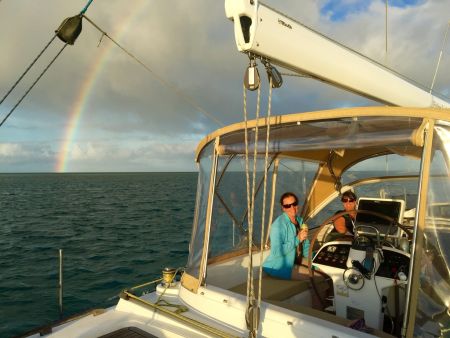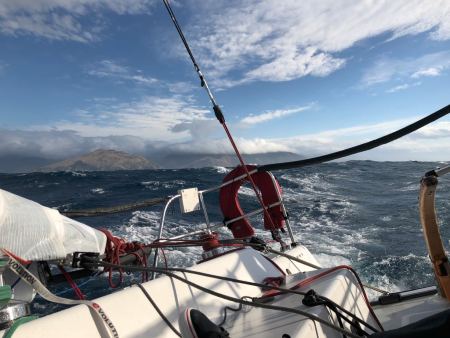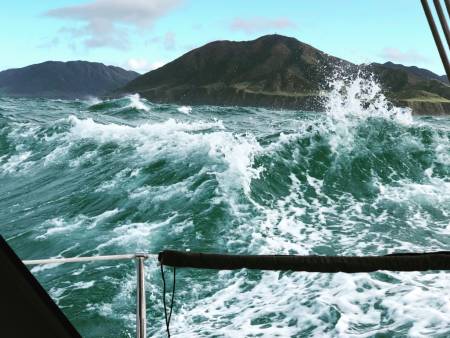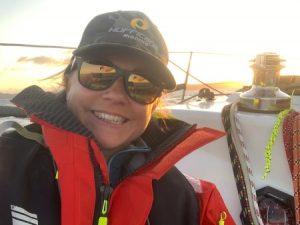INSIGHTS: Helping Your Friends and Family Help You
When you are out sailing in the middle of the ocean, it is so good knowing that you have got people back home who are able to assist you if – or when – you need them. New Zealand sailor and regular INSIGHTS contributor Viki Moore passes on some valuable advice.
Published 4 years ago, updated 1 year ago
A few years ago we were sailing in New Caledonia, anchored inside a small reef with the sun going down. It was a lovely spot, but there were dark clouds on the horizon and the wind was increasing. It struck me that no one back home really knew where we were, which boat we were on, where we were going, when we were due back, or the emergency contact details of our other friends on the boat. We had told some friends back in the marina our rough plans, but he didn’t know our families contact details and neither did the boat owner, who was back in New Zealand.


Had we set off the boat’s EPIRB, the person on the owner’s call list would have been advised that we were in trouble, but they wouldn’t have known how to contact our families to let them know what was going on. I am sure they would have eventually figured it out, but it wouldn’t have been easy.
Who is on your Call List?
So consider this. What if you set off your EPIRB and the Rescue Coordination Centre picks up the phone to speak to the first person on your call list. Who are they going to speak to? And is that person going to be able to pass on any vital information to assist with your rescue?
Or what if you are overdue, no one has heard from you for a while, and you are bobbing about in your life raft hoping that eventually someone, anyone will raise the alarm…?
The contact details on my EPIRB registration are my Mum, Dad, brother and yacht club. They are all pretty likely to know where I am and of course they are going to want to do all they can to assist with our rescue, but unless you have left them with some specific details, this may be very difficult for them to do.
Make it Easy for Everyone
My Mum isn’t a sailor, and a phone call to her is probably just going to send her in to a panic. So to make your emergency contact person’s life a lot easier, you could consider leaving a folder with the following information, all of which can give the Rescue Coordination Centre valuable pieces of the puzzle and make things much easier for formulating a rescue.
For a short coastal passage I simply email all the crew and their emergency contacts, the names and contact details of everyone else on board, the name of the boat, and the departure and arrival ETAs.


Useful Information
However if you are venturing further afield here are some ideas on what could be useful to include.
- A Trip Report – Details of the port you are leaving, the port you are heading to, your route, any potential places you are planning or could potentially stop at along the way, the charts you have on board, and your estimated time of arrival. Perhaps you could send through a copy of your Passage Plan. How will you contact them when you arrive or to advise you are ok? Will you be making Trip Reports on the radio as you sail along? Can they follow a tracker or your AIS signal? These details will obviously be changing for each trip, so this information could just be in the form of an email to your emergency contacts before you head off. Without this information and if someone is overdue, any search and rescue will be like finding a needle in a haystack.
- Other Yachts – If you are travelling with other vessels, leave their details as well, perhaps advise their blog page, satellite phone number etc. Give your buddy boat your emergency contact details as well.
- If you are Overdue – Discuss with your contacts what they should do if you are overdue, explain that you might not be able to keep in touch when you are at sea, but when (and how) should they raise the alarm if they haven’t heard from you by the agreed time?
- Contact details for the Rescue Coordination Centre – Give them the telephone number of who to call if you are overdue. The best is the contact details for the Rescue Coordination Centre in your country of residence (or where your EPIRB is registered) or ask them to call the Police. These people are super helpful, and they can discuss the options for starting a search if necessary.
- Boat Description and Photographs – Describe your boat in detail, give the name, length overall, color and type of vessel. Include other details like the model, and color of your dinghy, and life raft and other safety gear on board. Add a description of dodgers, awnings, sail covers and colours. Also have the registration number, sail number or documentation number and EPIRB registration number.
- Add photos – Take outside shots of the bow, beam, and stern, and leave them with digital copies as well as printed copies that can be emailed.
- Crew Details – include their names, gender, age, address, passport copies, emergency contact person details, and a clear full face photo of the skipper and regular crew. Note if anyone has any medical conditions that require medication or monitoring. The more the Rescue Teams know ahead of time, the better equipped they will be to make the best decision for an injured or sick crew member.
- Insurance Details – Leave a copy of your insurance policy, and contact details of the insurer. Give your insurance company the details of your emergency contact person, so they have the authority to act on your behalf. If it turns out that the boat has lost its rudder or mast for example, and requires a tow- the insurance company will need to be informed. Also leave details of your health/travel insurance and life insurance policies.
- Emergency Gear – List all the safety gear you carry. Include life jackets, radios, EPIRB, liferaft (with color and model/type), flares, survival suits, bilge pumps etc. Describe the contents of your grab bag.
- Navigation & Communication – detail all the navigation equipment aboard: AIS, GPS (include installed and hand-held), Chart Plotter, radar, and other electronic navigation devices. Also satellite phone numbers, VHF Radio Call Signs, SSB Radio, the registration numbers of the EPIRBs and PLBs on board.
- Sails & Engines – detail all the sails carried, the colour, sail numbers and logos, and sailing rig (sloop, cutter, ketch, yawl). Provide engine make, model, horsepower and average speed. Detail the fuel tank capacity and extra fuel carried.
- Passwords – You might like to leave passwords to your email, bank accounts, social media etc. Ensure these are kept in a safe place with a trustworthy person. Or better yet, get a power of attorney written up before you leave.
- Media – I often cringe about the way boating rescues or disasters are portrayed in the media. When journalists aren’t given all the background information sometimes the articles can sound like the sailors were inexperienced or the boat not well maintained. Consider how you’d like your rescue to be written if it was on the front page of the paper, and perhaps ask your shore contact to make a statement to the media with the facts of what happened with your side of the story.
Print and Electronic Copies of Important Information
If you have a printed and electronic copy of this information, it can be quickly passed on to the Rescue Coordination Centre to assist with their rescue plans. You have automatically given them a lot more information than they had to start off with.
This information will give some big clues to your rescuers, will mean your loved ones aren’t having to scratch around looking for all the details they require and may make a huge difference in expediting your rescue.
Also remind your shore crew that just because someone is overdue, doesn’t necessarily mean that they are in trouble. There are many reasons why they wouldn’t be able to get in touch. You can be out of cell phone range, satellite phones can get wet or break and the boat might not have an SSB radio on board. Most sailors would hate to think that there were people out searching for them when they were actually safe and sound.
On the same token though, your boat could have sunk before you had the opportunity to set off your EPIRB, and you could be sitting in a life raft for some time before someone realises you are overdue.
So when should they raise the alarm?
The Rescue Coordination Centre said they were happy to take enquiries from people who had concerns.
Also don’t underestimate the power of Social Media. There are a lot of different sailing Facebook groups These global networks are extremely useful for contacting people who are actively out on the water and asking them to keep a look out for any overdue boats. Advise your contacts of the groups you are a member of and ask them to post pictures and provide specific boat and location details, asking people to share on their local networks to assist in any search efforts.


Tracking Systems and AIS
These days we have the added bonus of tracking systems, like Spot Trackers and AIS which make finding boats, or at least their last known positions a lot easier. Vessels in the area can be contacted and asked to keep an eye out. Sailors can put regular posts on blogs and social media channels via satellite text messaging, and if they include their position, course and speed, these too can provide vital clues to narrow down a search area.
With any luck this all makes things much easier for rescuers to find you!
But the fun doesn’t stop once you have been rescued either… chances are you didn’t have time to take your passports or credit cards off the boat, so it is entirely possible you could be left without any ID or funds, and while your passage might have just been from New Zealand to Fiji, the ship that picks you up might be heading for Panama, and they won’t be turning around to drop you off.
So once again your contact person back home will need to play an important part in your second ‘rescue’.
Copy Important Documents
If you have left copies of your passports, then this will make life a bit easier. Ask your contact person to get in touch with your local embassy in the country you are heading to. Also you might consider leaving a trusted person with details of your bank accounts to be able to access funds to send to you. You might need to pay for medical care, purchasing clothing, tickets to come home, accommodation and new passports. Use those Social Media channels again to ask if anyone is in the area and willing to assist some sailors in need.
So while no one wants to ever end up in a rescue situation, hopefully these tips might make things go a bit more smoothly.
…………………………………………………………………………………………………………………………………..


Viki Moore is a sailor based in Christchurch, New Zealand. She owns a Young 88 that she enjoys cruising and racing around the South Island. She is the President of The Little Ship Club of Canterbury, founder of Women Who Sail New Zealand and is a Director of Yachting New Zealand. She enjoys writing about her sailing adventures on her blog www.astrolabesailing.com.
Read Viki’s other articles for INSIGHTS
…………………………………………………………………………………………………………………………………..
Related Links:
- Safety: The Importance of a Float Plan (Glen Tuttle – BoatWatch)
- Creating a Float Plan: What and Why (SV Totem)
- Other INSIGHTS can be found here.
…………………………………………………………………………………………………………………………………..
The opinions expressed in this article are the author’s own and do not reflect the view of Noonsite.com or World Cruising Club.
Related to the following Cruising Resources: Cruising Information, Insights, Planning and Preparation, Safety, Safety and Medical


Thanks Viki, that’s really important information. One more bit of useful information about family and friends helping you when you are out of the country. Many cruisers depend on their family and friends to help them get supplies and parts for their yacht when the parts they need are not available locally. That turns out to be a big mistake, not only because it’s imposing on your friends and family, but because when they order and send something on to you it will cost them a lot of time and effort but it will cost them (and you) a lot more to send your stuff than a professional mail forwarding service costs. Here’s a link to my own experiences with mail forwarding for yachts. https://cruising-newcaledonia.com/mail-forwarding-service-for-cruising-yachts.html
Thank you Viki!